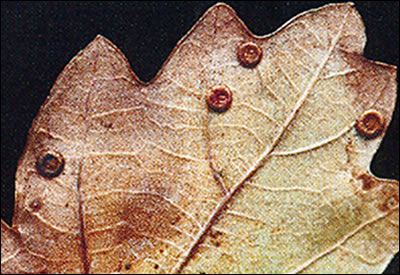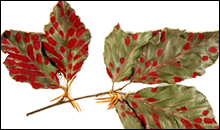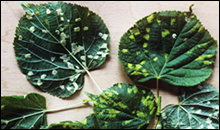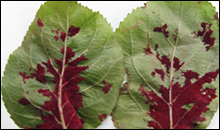GALL MITES
Gall mites are minute animals usually less than 0.2mm long when fully grown. They have long bodies and two pairs of legs, unlike other mites which have four pairs. Their size means they can usually only be seen with the aid of a microscope. Their presence is readily detected by the distinctive abnormal plant growths induced by their feeding activities.
There are many species of eriophyid mite which are usually host specific; this means that each species of mite will only feed on a single or closely related plant species. They feed by sucking sap but while doing so secrete chemicals into the plant, they then grow to produce the gall. The mites can suck sap from plant cells lining the gall structure, which are invariably more nutritious than unaffected tissue, but often do not cause serious damage to the plant
Symptoms
Each species of gall mite produce a recognizable set of symptoms these include;
- Excessive growth of hairs on the foliage
- Thickening of leaf margins
- Enlargement of buds
- Stunting of shoots
- Proliferation of growth to produce witches' brooms
- Blistering of the foliage
- Development of hard raised structures on the leaf surface
Gall mites show little variation in their life cycles. Most overwinter on their host plants as non-feeding females in crevices in the bark, especially near buds or underneath the bud scales. In the spring when the host plant comes into growth, the mites begin feeding and laying eggs. Up to about 80 eggs may be produced at a rate of two to three a day. They hatch into miniature versions of the adult mite. There may be two or three generations during the summer with both male and female adults being present. In late summer overwintering females are produced which will not lay eggs until the following year.
The varieties you are most likely to encounter are;-
- Apple gall mite: causes creamy-white or reddish-purple patches of hairs on the undersides of edible and crab apple leaves.
- Ash gall mite: feeds on flowers and prevents them from developing into fruits. The flowers become clubbed woody structures that persist after leaf fall.
- Beech leaf roll mite: causes leaf margins curl upwards to form a tight marginal roll which can lead to more extensive leaf distortion.
- Birch big bud mite: results in enlarged buds that fail to develop; frequently found in witches' broom growths; initiated by fungal attack.
- Birch felt gall mites: causes dense creamy-white hairs to develop on the leaves, mainly on the underside. Leaves are often distorted.
- Elm pimple gall mite: results in small whitish-green hard raised structures on the upper leaf surface.
- Hawthorn leaf margin mite: results in pale thickening and downward curling of the leaf margins.
- Holm oak felt gall mite: leads to patches of rusty brown hairs to develop on the underside of leaves
The Larvae secretes chemicals that induce the plant to produce gall tissue. Each disc contains a single grub. They are harmless but unsightly, remove by hand.


- Maple pimple gall: causes globular galls up to 5mm high on the leaf surface of maples which can be very numerous. They are wrinkled and a glossy yellowish green or red, becoming dark red or black.
- Plum leaf gall mite: produces swollen whitish or yellowish-green growths on the leaves, especially around the margins and on the
- Yew big bud: results in enlarged rounded buds that fail to open. Can also induce distorted and abnormally long shoot extension.

Birch

Lime

Elm

Crab Apple
In light infestations of gall mites it may be possible to remove galls, infested leaves or shoots to stop the mites spreading all over plants. However, taking infested leaves off heavily affected plants will often do more harm than the mites.
There are currently no pesticides available to home gardeners that are effective against gall mites, so their presence often has to be tolerated.